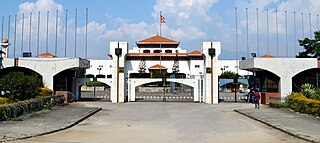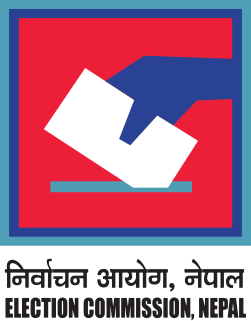Related Research Articles

Nepal, officially the Federal Democratic Republic of Nepal, is a landlocked country in South Asia. It is mainly situated in the Himalayas, but also includes parts of the Indo-Gangetic Plain, bordering Tibet of China to the north, and India in the south, east, and west, while it is narrowly separated from Bangladesh by the Siliguri Corridor, and from Bhutan by the Indian state of Sikkim. Nepal has a diverse geography, including fertile plains, subalpine forested hills, and eight of the world's ten tallest mountains, including Mount Everest, the highest point on Earth. Nepal is a multi-ethnic, multi-lingual, multi-religious and multi-cultural state, with Nepali as the official language. Kathmandu is the nation's capital and the largest city.

The Nepal Workers and Peasants Party (NMKP), also known as the Nepal Majdoor Kisan Party and abbreviated Nemkipa, is a political party in Nepal. The party was founded on 23 January 1975 by Narayan Man Bijukchhe and draws most of its support from Bhaktapur. The party is sympathetic to the Workers' Party of Korea and Juche.

Tribhuvan University is a public university located in Kirtipur, Kathmandu. Established in 1959, TU is the oldest university in Nepal. In terms of enrollment, it is the 12th largest university in the world. The college offers 2,079 undergraduate and 2,089 postgraduate programs across a wide range of disciplines. Additionally, the institution has 61 constituent campuses and over 1,100 affiliated colleges across the country. Because it is government-funded, the tuition fees are less expensive than that of private (affiliated) college campuses.

The Terai or Tarai is a lowland region in northern India and southern Nepal that lies south of the outer foothills of the Himalayas, the Sivalik Hills, and north of the Indo-Gangetic Plain. This lowland belt is characterised by tall grasslands, scrub savannah, sal forests and clay rich swamps. In northern India, the Terai spreads from the Yamuna River eastward across Haryana, Uttarakhand, Uttar Pradesh, Bihar and West Bengal. The Terai is part of the Terai-Duar savanna and grasslands ecoregion. The corresponding lowland region in West Bengal, Bangladesh, Bhutan and Assam in the Brahmaputra River basin is called 'Dooars'. In Nepal, the term is applied to the part of the country situated north of the Indo-Gangetic Plain. Nepal's Terai stretches over 33,998.8 km2 (13,127.0 sq mi), about 23.1% of Nepal's land area, and lies at an elevation of between 67 and 300 m. The region comprises more than 50 wetlands. North of the Terai rises the Bhabar, a narrow but continuous belt of forest about 8–12 km (5.0–7.5 mi) wide. The Terai of Nepal was also known by the name 'Madhesh'.

The National Assembly or Rastriya Sabha is the one of the houses of the Federal Parliament of Nepal, the other house being the House of Representatives. The composition and powers of the Assembly are established by Part 8 and 9 of the Constitution of Nepal. There are a total of 59 members: 8 members are elected from each of the seven provinces by an electoral college of each province, and three are appointed by the President on recommendation of the government.

Education in Nepal was long based on home-schooling and gurukulas. This was similar to the former Indian system of education, in which the pupils would learn either in their homes or with reputed priests or Gurus. Before Nepal was declared a democratic country, the general public had no access to formal education. The first formal school, Durbar High School, established by Jung Bahadur Rana in 1853, was intended for the elite. The birth of Nepalese democracy in 1951 opened its classrooms to a more diverse population. Education in Nepal from the primary school to the university level has been modeled from the very inception on the Indian system, which is in turn the legacy of the old British Raj.

The Nepalese democracy movement is a series of political movements from the 20th century to 2008 that advocated the establishment of representative democracy, a multi-party political system and the abolition of monarchy. It has seen three major movements, the Revolution of 1951, Jana Andolan and Loktantra Andolan which ultimately abolished the Shah monarchy, transitioned Nepal towards a republic and reintroduced multi-party bicameral democracy.

The Digital Himalaya project was established in December 2000 by Mark Turin, Alan Macfarlane, Sara Shneiderman, and Sarah Harrison. The project's principal goal is to collect and preserve historical multimedia materials relating to the Himalaya, such as photographs, recordings, and journals, and make those resources available over the internet and offline, on external storage media. The project team have digitized older ethnographic collections and data sets that were deteriorating in their analogue formats, so as to protect them from deterioration and make them available and accessible to originating communities in the Himalayan region and a global community of scholars.
The term Madheshi people is used for people of Indian ancestry residing in the Terai of Nepal that comprises various cultural groups such as Hindu caste groups, Muslims, Marwaris and indigenous people of the Terai. Since the late 1940s, the term 'Madhes' was used by politicians in the Nepal Terai to differentiate between the interests of the people of the Terai and of the hills. In recent times, some politicians and journalists use the term for all Nepali citizens of the Terai.
Kul Prasad Uprety, a Nepalese politician. Uprety contested the 1991 Nepalese legislative election as a Communist Party of Nepal candidate in the Taplejung-1 seat. He won the election, defeating Nepali Congress candidate Mani Lama, with 12703 votes (47.19%). In the 1994 election, he was substituted by Ambika Sawa as the CPN(UML) candidate in the constituency.
Basanta Kumar Nemwang is a Nepalese politician and former Minister of Physical Infrastructure and Transport.He also served as Minister of Agriculture and Livestock Development,Minister of Water Supply, Minister of Information and Communications and Minister of Urban Development in Second Oli cabinet. He is Member of Parliament, belonging to the Communist Party of Nepal. Nemwang has contested the Panchthar-1 constituency in all three legislative elections held since 1991. His main opponent in all three elections have been Nepali Congress leader Dipak Prakash Baskota.

The United States established official relations with Nepal in 1947 and opened its Kathmandu embassy in 1959. Relations between the two countries have always been friendly. U.S. policy objectives toward Nepal center on helping Nepal build a peaceful, prosperous, and democratic society.

Prakash Man Singh is a Nepalese politician and a leader of the Nepali Congress. He is the son of political stalwart Ganesh Man Singh. He has also served as the Deputy Prime Minister and Minister of Local Development and Federalism in Sushil Koirala's Cabinet.

The Election Commission is a constitutional body responsible for conducting and monitoring elections, as well as registering parties and candidates and reporting election outcomes, in Nepal. It was born out of the 1950 revolution in Nepal, and was established in law in 1951, although it has been changed somewhat by law over time. It has six members who serve for six-year terms, as established by the Constitution of Nepal. During the Constituent Assembly elections in 2008, it was criticized for not fully upholding its duties, but was acknowledged to have managed the elections well nonetheless.

Panchayat was a partyless political system incepted by King Mahendra by sidelining the Nepali Congress government of B. P. Koirala on 15th December 1960 AD. He introduced the partyless Panchayat system on 5th January 1961 AD. Under his direct rule King Mahendra introduced the four tiered structure—village, town, district and national Panchayat—on the basis of limited elected executive committee. Mahendra consolidated power by institutionalizing and invoking the three pillars of national identity—Hindu religion, Nepali language and Monarchy—as a foundation of everyday social and religious life. Moreover, the system propagated the idea of Ek Raja, Ek Bhesh, Ek Bhasa, Ek Desh.

Rastriya Panchayat was the official legislature (parliament) during the Panchayat regime of Nepal that effectively functioned from 1960 to 1990. Its head office was at the "Gallery Baithak" in Singha Durbar, Kathmandu. In the 1980s, it consisted of more than 120 members among which 105 members were directly elected by the people, while the king was to nominate 20 percent of its members, i.e. 19 members were nominated by the monarch.

The Provinces of Nepal were formed on 20 September 2015 in accordance with Schedule 4 of the Constitution of Nepal. The seven provinces were formed by grouping the existing districts. The current system of seven provinces replaced an earlier system where Nepal was divided into 14 administrative zones which were grouped into five development regions.

Province No. 1 is a province of Nepal. It is located in easternmost part of Nepal. It is surrounded by Tibet of China to the north, the Indian states of Sikkim and West Bengal to the east and Bihar to the south and Bagmati Province and Province No. 2 to the west.
Surya Raj Acharya is a Nepalese politician, and a public intellectual as an independent expert in development and infrastructure policy. He was a Visiting Professor at Institute of Engineering, Tribhuvan University before joining Sajha Party. He was spokesperson of Sajha Party. Acharya lives in Bharatpur Metropolis in Chitwan District, Nepal.
Florian Krampe is a German/Swedish political scientist and international relations scholar at the Stockholm International Peace Research Institute (SIPRI).[2] He is best known for his work on climate-related security risks, Environmental Peacebuilding, and the governance of natural resources after armed conflict. Since 2020 he is cross appointed Specially Appointed Professor at the Network for Education and Research on Peace and Sustainability at Hiroshima University, Japan.
References
- ↑ Local News The Rising Nepal (Daily) Archived 2006-01-08 at the Wayback Machine
- ↑ Institute for Development Studies. Third General Election: Emerging Scenario. Kathmandu: Institute for Development Studies, 1999. p. 15, 25.